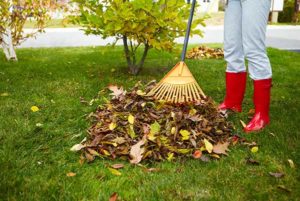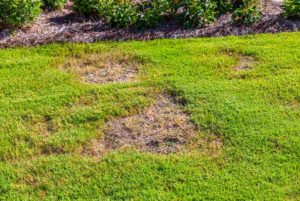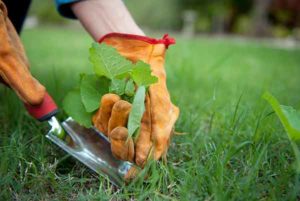10 Lawn Care Mistakes You Don’t Want To Make This Fall
As a professional lawn care company with over 35 years of experience, we know a thing or two about common lawn care mistakes. If you want a lush, green lawn when spring rolls around, it’s best to begin your preparation in the fall. Here are ten common fall care mistakes that you can avoid for your Spring lawn’s benefit.
1. Ignoring Fallen Leaves

Raking leaves is a tedious, but vital task to your lawn’s health. Fallen leaves that aren’t removed smother grass by keeping sun and air out. Rake often to keep your lawn cleared and healthy.
2. Using the Wrong Type Of Winterizer
Fall is the ideal time of year to fertilize your fescue or bluegrass lawn. The cooler fall temperatures lead to faster growth and the added nutrients are essential to repairing summer damage. A winterizer with a high nitrogen content will boost your lawn’s health and give it a jump start in the spring. Nitrogen is going to be stored in the plant for spring when the conditions are ready for growth. In most cases, you should avoid winterizers with higher levels of phosphorus or potassium. Too much of N-P-K (nitrogen, phosphorus, potassium) can cause more plant health issues over time. Look for a product that contains at least 20-25% nitrogen and 0-5% phosphorus and potassium for the best results.
3. Forgetting To Mulch
Mulching around your trees and landscape beds is a must for fall lawn care as the benefits of mulch are too great to ignore. In addition to helping the soil retain moisture and heat, mulch also nurtures soil microbial activity for more nutrient-rich ground. Another great benefit of adding mulch is that mulch smothers weeds, keeping your plants healthier and cutting down maintenance.
4. Mowing With Dull Lawn Mower Blades
An entire summer of regular lawn mowing dulls your mower blades, tearing the grass instead of cutting it. If your grass looks shabby instead of cleanly cut, it’s time to sharpen your lawn mower blade. Fall is a good time to sharpen them since the mower is not in use as much.
5. Not Doing Anything

It is often a struggle to find the time for lawn care during the busy fall back-to-school months.
Let’s face it, Fall is often a busy time for people. Between back-to-school activities, end-of-summer vacations, and falling temperatures, lawn care often goes overlooked. Ironically fall is also arguably the most important time for lawn care, and is a crucial season to supply your lawn with essential nutrients like potassium.
Choosing the right fertilizer to use as a winterizing agent is important and we recommend taking a soil analysis to get a good idea of which nutrients are lacking.
6. Delaying Aeration Until Spring
A lot of people think the spring months are better for lawn aeration, but fall is actually the preferred season for this activity due to cool air temperatures, and warm and soft soil. Fall aeration will give your lawn’s roots the boost they need to help recover from the hot summer months.
Disrupting the soil of your lawn by aerating it with heavy machinery weakens the turf and heightens the risk of seeing crabgrass growth. Many lawns receive a barrier treatment in the spring to prevent crabgrass before it grows, but aerating can cause this barrier to fail, making spring a less convenient time to aerate. Crabgrass also thrives in the hot temperatures of summer, so saving your aerating for the cooler fall months reduces the risk of crabgrass seeds germinating and taking over your lawn.
7. Leaving Bare and Thinning Spots Until Spring

Spring planting limits your ability to use a pre-emergent for weed control, which can negatively impact how the grass seed takes. Newly germinating grass is also sensitive and susceptible to summertime stresses, such as heat, insects, drought, and weeds, making the cooler temperatures of fall an ideal time to plant.
8. Overwatering and Not Watering at All
Watering your lawn during fall generally requires a different approach than summer watering. Importantly, watering in autumn typically requires less water. Increased rainfall with fall storms provides much of the water your lawn needs, so you won’t need to water manually as much during stormy conditions. Keep an eye on local forecasts and water accordingly.
Most lawns need around one inch of water per week for optimal health. If you water too much, you increase the risk of lawn diseases, or the grass failing to develop a deep and strong root system. Not watering at all leaves your lawn susceptible to fungus growth, discoloration, and a deterioration of soil quality. Pay attention to the appearance of your lawn along with the amount of rain your area receives so you can adjust your watering habits accordingly.
9. Ignoring Weed Management

Use hands tools such as a garden shovel to remove the entire weed including the root.
Never assume lawn weeds stop growing in the fall months. Many people think that continued weed control is no longer necessary as the weather gets cooler, but this strategy can leave your lawn in a mess when the weather heats up again. Remove visible weeds by hand or with a trimming tool. You can also apply a weed control treatment in the fall to prevent many perennial weeds from becoming a nuisance in the spring, and overall improves your lawn’s health.
10. Cutting Your Lawn Too Short
Don’t cut your lawn too short in the fall. Cutting it too short leaves the lawn at risk for weeds, and leaves brown or bare-looking spots in your lawn. The best practice is to cut no more than one-third of the grass blade each time you mow. The overall height of your grass depends on the type you have in your lawn, but three inches is a good average height. If you let your lawn grow past the optimal height, you should plan on mowing more frequently until your grass is back to the proper height instead of mowing off too much at one time.
Fall Lawn Care Experts
Concerned about your lawn care and the health of your lawn in the long run? Contact Ryan Lawn & Tree today for a Free Estimate. We take pride in ourselves on finding answers to all your questions and solutions to fit your lawn care needs.









